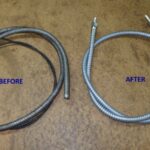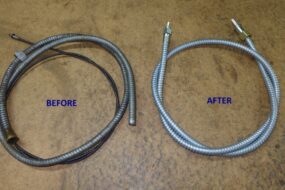The radiator contains piping through which the coolant circulates, losing heat. The thermostat is typically a spring-loaded valve that opens and closes according to the temperature of the coolant.
A good-quality antifreeze of the ethylene-glycol type, with full anticorrosive additives, should be left undisturbed in the cooling system for about three years — summer and winter.
After that time, flush the system (See How to flush an engine radiator) and replace the coolant with fresh antifreeze mixture. Do not drain the system during summer and replace the mixture with water — that leads to rapid corrosion.
If you do not know how long the coolant mixture has been in the system, or if you have any doubts about its effectiveness, drain and discard it.
In time the mixture loses its anticorrosive properties. Replace it with a new mixture of the strength specified in your car handbook.
For driving in Europe, the proportion rarely exceeds half water and half anti freeze.
Antifreeze damages paintwork. Wrap rags around the filler neck to contain spillage. If any does get on to the paintwork, wash it off with plenty of water at once. A kitchen utensil used for draining antifreeze must not be used again in the kitchen.
Note that antifreeze is poisonous and must be disposed of properly, not poured down a drain. Check with your council waste-disposal department where it can be dumped.
There have been two types of antifreeze in use. The cheapest is based on methyl alcohol (methanol), which can evaporate during use, resulting in a progressive loss of effectiveness. It is also inflammable, and is no longer recommended by car makers.
The ethylene-glycol type is more stable and does not evaporate. You can weaken it only by topping up with plain water.
Whichever brand you choose, make sure that it is approved by the car manufacturers for your type of engine.
Choose one that contains corrosion inhibitors. The container should state that the contents are suitable for all types of engine, including aluminium blocks or cylinder heads.
Replace hoses that show signs of cracking when squeezed. Check all the hose clips (See Checking hoses and the radiator cap).
If there is corrosion at any junction, remove the hose and clean the metal pipework. Consider renewing the hose.
If you can see slime or dirt in the cooling system, take the opportunity to flush it out. If you have any doubts about the correct operation of the thermostat, check it (See How to replace a car thermostat), and renew if faulty.
Draining and refilling the system
Use a 2 gallon watering-can to mix antifreeze solution.
Let the engine cool and place a container under the drain point. If there is no drain tap on the radiator – or if the tap has stuck unclip and pull off the bottom hose. Remove the radiator filler cap to speed the flow.
Before you start to refill the system, make sure that you have checked and refitted all the hoses, tightened all the hose clips, and closed all drain taps.
Pour in the correct amount of antifreeze, then top up with water or mix the antifreeze solution in a watering-can and use that to pour it in.
If your car has an expansion tank, replace the coolant there with the correct mixture, but do not fill the expansion tank to the top.
With the radiator cap off, run the engine until the coolant in the radiator is warm.
Top up until the level remains constant. Refit the radiator cap.
Spread some newspapers on the ground and park the car with the engine and radiator over them, to isolate any leaks.
Topping up antifreeze
If you have a coolant loss, top up with the correct strength of antifreeze mixture. Adding plain water weakens the mixture.
Avoiding leaks
Coolant mixture finds its way through leaks or weak hoses more quickly than water, so make sure that all connections are tight. Take care not to overtighten hose clips, because this can damage the rubber and cause a leak. Smear washing-up liquid in a new hose: it will slip on more easily.
Use an antifreeze (nota battery) hydrometer
Draw in enoughcoolant to movethe float or balls.
Use an antifreeze hydrometer. Suck in coolant from the header tank; if there is a float, take a reading where the float breaks the liquid surface and convert to antifreeze strength on the hydrometer chart. If there are balls, the numbers and colours floating show the strength;check the instructions.







